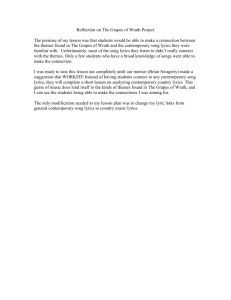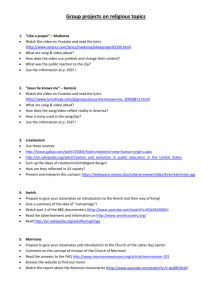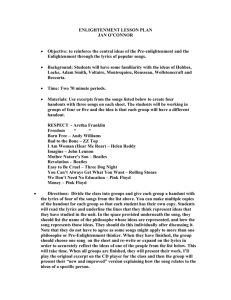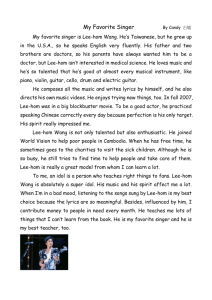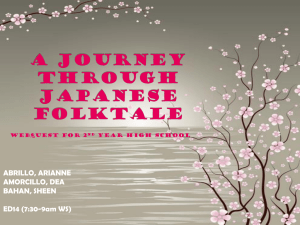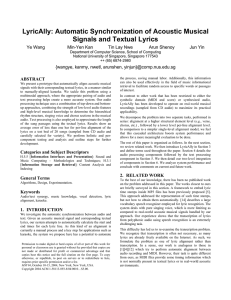Unit 4 - Music Terminology
advertisement
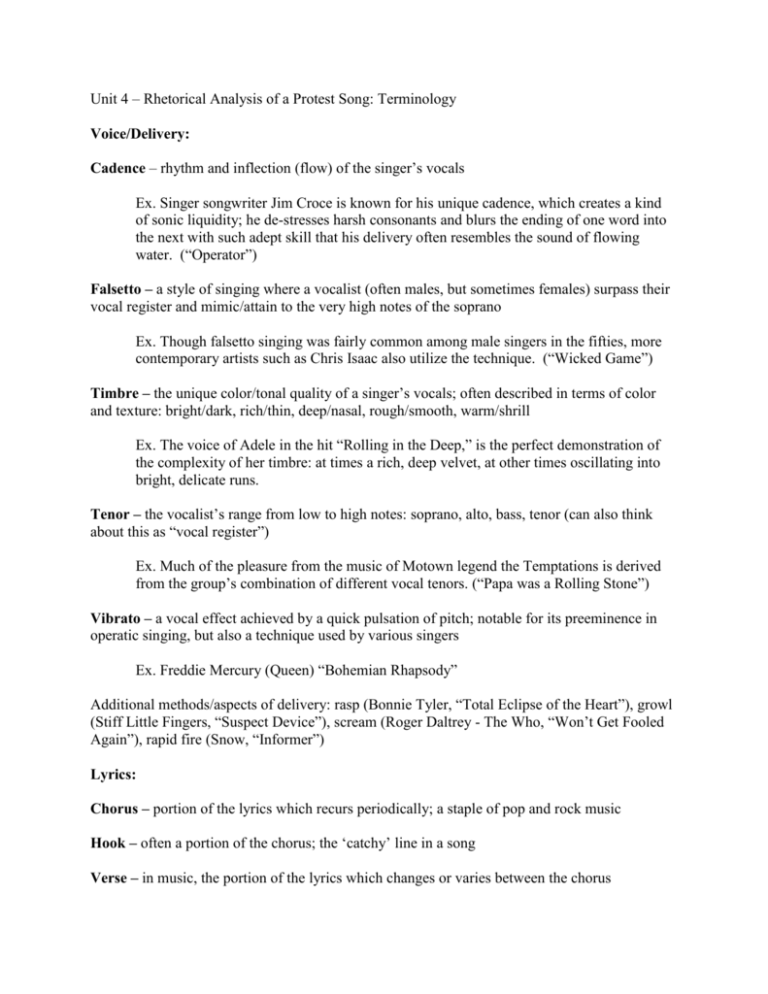
Unit 4 – Rhetorical Analysis of a Protest Song: Terminology Voice/Delivery: Cadence – rhythm and inflection (flow) of the singer’s vocals Ex. Singer songwriter Jim Croce is known for his unique cadence, which creates a kind of sonic liquidity; he de-stresses harsh consonants and blurs the ending of one word into the next with such adept skill that his delivery often resembles the sound of flowing water. (“Operator”) Falsetto – a style of singing where a vocalist (often males, but sometimes females) surpass their vocal register and mimic/attain to the very high notes of the soprano Ex. Though falsetto singing was fairly common among male singers in the fifties, more contemporary artists such as Chris Isaac also utilize the technique. (“Wicked Game”) Timbre – the unique color/tonal quality of a singer’s vocals; often described in terms of color and texture: bright/dark, rich/thin, deep/nasal, rough/smooth, warm/shrill Ex. The voice of Adele in the hit “Rolling in the Deep,” is the perfect demonstration of the complexity of her timbre: at times a rich, deep velvet, at other times oscillating into bright, delicate runs. Tenor – the vocalist’s range from low to high notes: soprano, alto, bass, tenor (can also think about this as “vocal register”) Ex. Much of the pleasure from the music of Motown legend the Temptations is derived from the group’s combination of different vocal tenors. (“Papa was a Rolling Stone”) Vibrato – a vocal effect achieved by a quick pulsation of pitch; notable for its preeminence in operatic singing, but also a technique used by various singers Ex. Freddie Mercury (Queen) “Bohemian Rhapsody” Additional methods/aspects of delivery: rasp (Bonnie Tyler, “Total Eclipse of the Heart”), growl (Stiff Little Fingers, “Suspect Device”), scream (Roger Daltrey - The Who, “Won’t Get Fooled Again”), rapid fire (Snow, “Informer”) Lyrics: Chorus – portion of the lyrics which recurs periodically; a staple of pop and rock music Hook – often a portion of the chorus; the ‘catchy’ line in a song Verse – in music, the portion of the lyrics which changes or varies between the chorus Rhyme – a poetic device often used at the ends of lines of song lyrics to fulfill a sense of expectation and delight the ear Repetition – in song lyrics, this can be a key phrase which appears throughout the lyrics as a way of tying together theme; a key component in the blues, where lines are often repeated twice or three times to underscore their meaning and emotion Imagery – a key component of many song lyrics, the image being a concrete description that grounds the theme/message in the senses Ex. Leonard Cohen, “Suzanne” Music: Melody – an organized succession of musical notes; aesthetically pleasing musical phrase Harmony – simultaneous combination of two or more notes or chords which creates a feeling of order/accord Dissonance – a simultaneous combination of two or more notes or chords which creates a feeling of unrest/uneasiness Ex. John Barnes Chance “Incantation and Dance”, Sonic Youth “Superstar,” Radiohead “Everything in its Right Place” Rhythm – the regular “beat” in music which keeps time; can be achieved via drums, bass guitar, and rhythm guitar Ambient Sound – the use of synthesizers, organ, or modified guitar to create the feeling of mood or atmosphere in a song; often (though not always) a song or portion of a song utilizing ambient sound will lack a sense of beat/rhythm or structured melody Ex. Pink Floyd “Echoes”, U2 “Bad” (here, ambient sound is created by the Edge’s modified guitar) Wall of Sound – a musical technique developed by producer Phil Spector in which the original music composition and lyrical performance are bolstered/overlaid with a dense background sound created by multiple guitars and/or orchestral instruments Ex. Tina Turner “River Deep, Mountain High,” The Beach Boys “Good Vibrations” (though in this track, Wall of Sound is also accompanied by ambient sound and a sense of dissonance) Bridge – a compositional element often used in rock/pop music; the section of the song which features a contrast (musically and sometimes lyrically) to the verses and chorus; provides a break from and anticipates return of verses/chorus Theme and Variation – a technique used in various kinds of music, including orchestral music and blues, in which a musical phrase is established as a prevailing theme and recurs throughout the piece in different variations Ex. B.B. King “Chains and Things” Solos – section of music performed by a single musician and may be lyrical or instrumental Ex. Led Zeppelin “Stairway to Heaven” Examples of Tone: Tongue-in-cheek – Rolling Stones “Lady Jane” Satirical – Country Joe and the Fish “Feel Like I’m Fixing to Die Rag” Accusatory/Aggressive – Sex Pistols “God Save the Queen” Lamentation/Melancholy – Bill Withers “Ain’t No Sunshine,” Johnny Cash “Hurt” Hopeful – Johnny Nash “I Can See Clearly Now” *Often, a singer’s lyrics/lyrical delivery can include multiple, juxtaposed tones – accusatory and lamenting, lamenting yet hopeful Rhetorical Terms for Your Consideration: Ethos – appeal to credibility Pathos – appeal to emotion (the English work “pathetic” derives from pathos) Logos – appeal to logic *In citing the use of rhetorical appeals, it is not necessary to use the Greek terminology (although it is fairly common to refer to the use of “pathos” or the “pathetic”); rather, it is more than sufficient, for example, to make a claim about how a singer/group/musician is appealing to a “credibility,” “emotion,” or “logic.” Though note that “credibility” and “logical” appeals will appear in the lyrics, whereas the pathetic appeal can appear in both lyrics and music.


